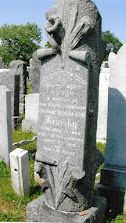In our last post, we talked about the importance of understanding some of the rituals and traditions surrounding funerals. We looked at coffins, caskets, and common practices that many associate with burying our loved ones. This week, we'll explore floriography, the symbolic meaning of plants and trees, so we can better understand some of what we see at funerals and cemeteries.
Flowers
Flowers have long held meaning for people surrounding death and mourning. They remind us that life is beautiful but also short. If you watched Prince Philip's funeral on Saturday, 17 April 2021, you may have noticed the lovely white roses and lilies on his casket, specially chosen by the Queen. Here are some flower symbols associated with death and dying. Look for these not only at funerals, but carved on tombstones or in bouquets left on gravesites.Lily: White lilies have several meanings. They symbolize renewal and rebirth, since they bloom early in spring, and their color reminds us of purity and innocence.
Rose: As with lilies, the white color symbolizes purity and innocence. Other colors have meaning too: peach and pink for sincerity and gratitude, red for love, and yellow for friendship.
Carnation: These symbolize love and also motherhood. For a Christian, the carnation may refer to honoring the spirit of Christ.
Hyacinth: Purple has long been a symbol of sorrow and loss.
Chrysanthemum: Americans see these as supportive and encouraging, but in Europe, they symbolize death and grieving, so they have come to be symbolic of both.
Forget-Me-Not: These lovely little blue flowers inspire remembering and a promise not to forget someone loved.
Wreaths
Using wreaths at funerals goes all the way back to ancient Greece.
- Their circular shape symbolizes continuity and the hope of eternal life.
- Wreaths made of evergreen boughs also symbolize strength and survival, since evergreens withstand harsh winters and bitter cold.
- In England, throughout several centuries, wreaths were part of funeral processions, covered in white blossoms and carried by young women for purity, or, during Victorian times, covered in symbolic flowers, as described above.
- The frames of wreaths, made of willow or cypress, also convey sorrow and mourning.
Flowers and Trees on Tombstones
Flowers have roots below ground and beauty above that bridge the visible and invisible worlds, the material and the spiritual. The flower symbolism used on tombstones is extensive, and using these symbols really had its heyday during the nineteenth century when Victorians created a virtual language of flowers. As we have already mentioned, lilies were very common, but you may see other flower carvings as well, and they were usually not done just for their aesthetic qualities. Flowers on tombstones almost always convey meaning. Here are just some examples:
- Acanthus: Overcoming obstacles, "prickly" journey of life (Acanthus have thorns.)
- Evening Primrose: Eternal love and hope
- Hawthorn: Hope
- Iris: Rainbows bridging heaven and earth, multiple parts of our personalities uniting
- Ivy: Friendship and eternal embrace
- Palm fronds: Victory, immortality, and comfort
- Trees: Usually depicted as stumps or as broken, symbolizing a young life cut short
- Wheat and Grapes: Bread and wine, the Sacraments
- Willow: Earthly sorrow
As we wander in cemeteries or collect photos of our ancestors' gravestones, we want to be sure we pay attention to the symbolic designs their mourning families left for us to interpret.
More Sources of Information
“7 Popular Sympathy Flowers and Their Meanings,” Funeral Basics, 2021 https://www.funeralbasics.org/7-popular-sympathy-flowers-meanings/
"The History and Tradition of Funeral Wreaths," Flowers & Sympathy, 2020 https://www.flowersandsympathy.com/funeral-wreaths/
"Flower Symbols and Meanings on Gravestones," Stoneletters, 2019 https://stoneletters.com/blog/flower-symbols-and-meanings-on-gravestones
Amanda Norman and Mark Kneale, "Headstone Symbols and Meanings," 2017 https://headstonesymbols.co.uk/headstone-meanings-and-symbols/flowers/



No comments:
Post a Comment
Note: Only a member of this blog may post a comment.